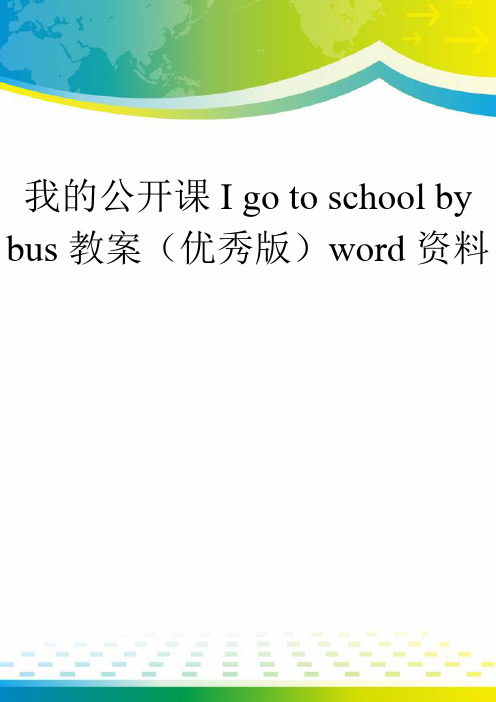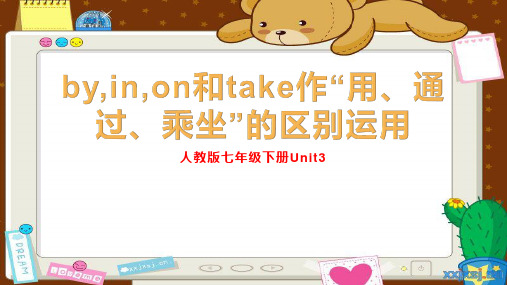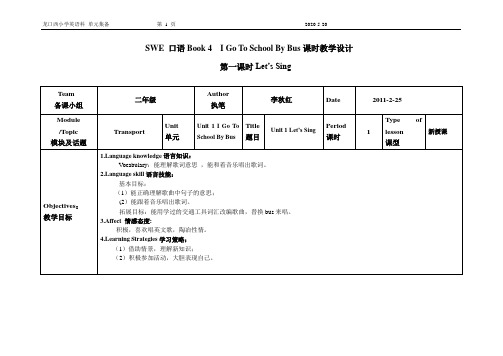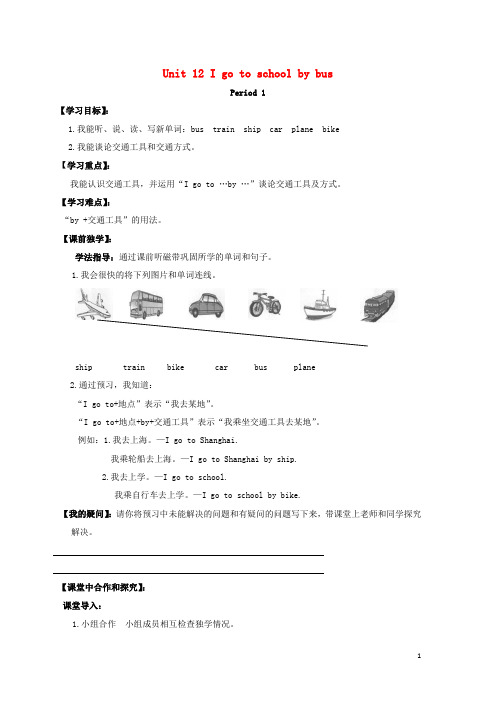i go to school by bus
- 格式:doc
- 大小:41.00 KB
- 文档页数:4

i often go to school by bus写出同义句我经常乘坐公共汽车去学校。
每天早上,当我起床的时候,我会准备好自己的书包和一些零食,然后穿好校服,准备上学。
因为学校离家有些远,所以我通常选择乘坐公共汽车去学校。
我喜欢坐公共汽车去学校,因为这样我可以欣赏到城市的风景,同时还能省去自己开车的时间和精力。
每天早上,我会提前几分钟到达公交车站,站在人群中等候车辆的到来。
有时候,车站上的人会很多,尤其是在早高峰期间,每个人都急匆匆地等待着下一辆车的到来。
当公交车终于来了,人们都会迅速排队上车。
一上公交车,我通常会找一个空位坐下来,然后拿出我之前准备好的书包和零食。
有时候,我还会利用公交车上的时间复习一下前一天的功课,这样我就能充分利用每一分钟。
公交车上,人们都很安静,专注地看着自己的手机或者阅读自己的书籍,每个人仿佛都进入了自己的小天地。
车辆在城市的大街小巷穿梭,经过一些热闹的商业街和拥挤的十字路口。
我喜欢看窗外飞驰而过的景色,有时候会发现一些新奇的事物,这让我觉得乘坐公交车真是一种有趣的体验。
虽然乘坐公共汽车上学很方便,但有时候也会遇到一些挑战。
在上学高峰期,公交车上的人很多,往往没有座位可坐,只能站着。
有时候车厢里会很挤,我不喜欢感觉被挤得无处可站。
而且,有时候会遇到路况拥堵,导致公交车行驶速度变慢。
这时候,我就需要耐心等待,也不能保证能够按时到达学校。
总的来说,乘坐公共汽车去学校是一种方便且有趣的方式。
通过观察城市的美景,我不仅能够提前到达学校,还能在车上充实自己。
当然,有时候也需要应对一些挑战,但这些挑战可以让我变得更加耐心和乐观。
我喜欢乘坐公共汽车去学校,这是一段我与城市共同成长的旅程。

我的公开课I go to school by bus教案(优秀版)word资料I go to school by bus. 教案幼专附小彭超群Teaching aims and requirements:1.知识目标:掌握词汇:bus, bike, plane, train, car,掌握句型:I go to school by ______.2.技能目标:用所学句型I go to school by _______. 谈论自己乘坐什么交通工具去哪儿玩。
Teaching main and difficult points:plane的发音,以及步行的表达法on footTeaching aids:交通工具卡片若干,自行车模型1一个,贴纸,课件等Teaching procedures:Step1. Lead-in(真实情景呈现,为导入做铺垫)T: Class begins! …Good afternoon, boys and girls. … Sit down, please.T: Look! Do you know it? (指自行车模型) What’s this?Who can tell me? Yes, it’s a bike.(贴自行车图片,写bike单词)(推着自行车往前走)I go to work by bike . I go to work by bike . 我呢每天都骑自行车上班。
(同时贴I go to work by bike.)(拿出bike卡片,拼读bike,延伸其它spell another word) sign with me (手势)T: Good!In this class, I will divide you into two groups, boys group and girls group. (呈现指示牌)If you did a good job, I’ll send you a bike sticker. Let’s have a competition. 男女同学进行比赛to see who can get the most bike stickers. 谁的自行车贴纸得得多。



Pep小学六年级英语专项训练一句型转换1.I go to schoolby bus(划线部分提问)You go to school?2.myhome is near the post office (划线部分提问)Your home ?3.you can take the NO. 12 bus(划线部分提问)Can I take ?4.I am going to buy some books(划线部分提问).You going to do ?5. is it far from here ?(做肯定回答和否定回答)6.I am going to cleanthe room this afternoon(划线部分提问)todo this afternoon? 7.he is going to read a book this afternoon(改为同义句) She read a book this afternoon8.Are you going to watchTV ? (做肯定回答和否定回答)9.I am going at 8;oo (划线部分提问)10 . I like playing football (划线部分提问)is hobby ?11.Does her uncle work in Si chan (做肯定回答和否定回答)12.Sarah goes to school on foot (变一般疑问句)Sarah school on foot13.Liu yu likes playing the violin (划线部分提问)Liu yu ‘s hobby?14.I read newspapers every evening (用he改写)newspapers every evening 15 he is my uncle (划线部分提问)he?16.he is a TVreporter(划线部分提问)Hedo?17.my father goes to work by bike (划线部分提问)Fathergo toschool ? 18.my sister works in a school(划线部分提问)your sister ?19.It comes from the vapour(划线部分提问)it from?20 can they help us ? (做肯定回答和否定回答)21.I am going to the cinema(划线部分提问)going?22. we should save water(划线部分提问)We do ?23. Does it come from the clond? (做肯定回答和否定回答)24. I am going to water the flower(划线部分提问)It from?25.I should dig the soil (划线部分提问)26. where does the clouds come from ?(更具实际情况回答)27.can you help me go up to the sky ?(做肯定回答和否定回答)28.I go to the cinema by bus(划线部分提问)do gotothe cinema29.I am going to thebook store this weekend. (划线部分提问)are this weekend?二按要求完成句子1.The library is in front of the park (划线提问)?2. we can go to the park On foot ( 改为否定句)3.Iam going to visit my uncle . (划线提问)?4.he is going to the Great wall(改为一般疑问句)?5. They are going to the shang hai next saturday (划线提问)?6.I like drawing picture(划线提问)?7.Chen jie likes playing the violin(划线提问)?8.Sarah likes listening to the music改为一般疑问句并否定回答做)?9 .He likes making kites(改为否定句)10.my brother is a reporter(划线提问)?11 .he works in a car company(划线提问)?12 .I often go to school by subway(划线提问)13 .He is xiaoming’s father(划线提问)is ?14. My mother teaches English(改为一般疑问句)your mother English?15. The cloud comes from the vapour(划线提问)?16. she is my aunt (划线部分提问)?17 .he can go with us (改为一般疑问句?18.I am going to buy an English book tomorrow划线部分提问?19,It is far from our school(改否定句)20.my home is near the post office划线部分提问your home?21.see yoy at 2’o clock写出答语22.I go to school on foot划线部分提问?23,I can go On foot 变一般疑问句?24.You can see the Science Museum on theleft改一般疑问句 ?25. Iam near the door划线部分提问?26.Is there a hospital near the here否定回答27.thank you very much 写出答语28.don’t forget the traffic rules改为同义句the traffic rules.29.The park is near the zoo划线部分提问?30.Are there books in the schoolbag否定回答31.I have a new dictionary变一般疑问句a new dictionary?32.We are going to write a letter划线部分提问going to ?33.MY father is going to Shang hai next week变否定句MY father Shanghai next week?34.I am going to the shoe store划线部分提问you ?35. I am going to plant trees变一般疑问句are you going to ?36.I am going to plant trees this weekend变一般疑问句goingtoplant trees this weekend?37.My father likes listening to music划线部分提问?38.IS there a stamp show on Sunday 否定回答39.I have a pen pal变为否定句40.Does he like playing the violin作出肯定和否定回答41. We like the same things变一般疑问句the same things?42.I like reading the bookS(用he 代替43.his sister lives in Japan划线部分提问sister ?44.I like playing football划线部分提问is ?45.My father works in a shoe factory划线部分提问?46.The tall man teaches us Chinese变一般疑问句the tall man you Chinese?47.She likes collecting stamps 改为否定句48.My mother is a reporter 划线部分提问does your mother ?49 .He works in a car company划线部分提问does he ?50.we often go to school by subway. 划线部分提问you often go to school?51. He is xiaoli’s father划线部分提问? 52.My mother teaches English划线部分提问Does your mother ?53. Is he a teacher? 做否定回答54.Her mother is a nurse划线部分提问?55.He works in a school划线部分提问?56 .Does Bill work in a school做肯定回答57. She is my aunt 划线部分提问?58.How exciting英汉互译59What’s Sarah’s hobby?改为同义句What Sarah doing?60.Is he your father?做否定回答61. The cloud comes from the vapour 变一般疑问句?62 .It come from the cloud划线部分提问?63.I am little Water Drop划线部分提问?64.The rain comes from the cloudthe rain from?65.Zhangpeng is from a big city 改为同义句Zhangzhang from a big city66.There are three traffic lights in every country?Traffic lights in every country?67.I am going to at 3 o’clock划线部分提问are you going、68 .Ican go on foot变一般疑问句go on foot?69.Iam going to buy food in the supermarket 划线部分提问going to buy in the supermarket?70.Liu yun likes playing the violin划线部分提问hobby ?71.He is going to France by plan next week划线部分提问he is going to Francenext wee二用所给动词的适当形式填空1.he (live )in hua nan with his parents2. (do) you go to school on foot every day3.I (like )watching Tvon the weekend.4. (do ) your mother like singing5.look! they are (make) kites6.her mother (teach) math in a middle school7.my father (go) to work at 7;308.do you like (read) newspapers after breakfast?9MrsBlack sings song .shi is a (sing)10.Do you like (swim) at the pool?11.what does your sister (do)?12Can he (make)kites with us13I am a policemam.I enjoy (help)people14 My father ( have ) a computer15.how can the water (become ) vapour ?16 the sun (shine ) and the water (become)vapour17.Little water Drop ( go ) higher ang higher .18My plant (have) two green leaves19 I will (go)20.I (be) hungry.21.he can (play)football22.he likes (ride) a bike23they like (watch) TV24.Amy (want) (be) a player.25 we (go ) to the Theme Park next week26My sister (go) to school on foot27.Do you like (draw) pictures28.What about (watch )TV29.Let’s(play) together30 your aunt (live ) in shanghai?31.there (be) some books on the desk.32 look! Tom is (run) on the road.33.we (go) to work by bus every day.34.I want (buy) some book.35you can (go) by .the No.4 bus .36.What are you going to (do) after school.37.The library (be) on the right.38.He usually (go) to school.39 .my brother (go) on foot40.Does your penpan like (draw)pictures?41.what about swim)this afternoon。

Unit 12 I go to school by busPeriod 1【学习目标】:1.我能听、说、读、写新单词:bus train ship car plane bike2.我能谈论交通工具和交通方式。
【学习重点】:我能认识交通工具,并运用“I go to …by …”谈论交通工具及方式。
【学习难点】:“by +交通工具”的用法。
【课前独学】:学法指导:通过课前听磁带巩固所学的单词和句子。
1.我会很快的将下列图片和单词连线。
ship train bike car bus plane2.通过预习,我知道:“I go to+地点”表示“我去某地”。
“I go to+地点+by+交通工具”表示“我乘坐交通工具去某地”。
例如:1.我去上海。
—I go to Shanghai.我乘轮船去上海。
—I go to Shanghai by ship.2.我去上学。
—I go to school.我乘自行车去上学。
—I go to school by bike.【我的疑问】:请你将预习中未能解决的问题和有疑问的问题写下来,带课堂上老师和同学探究解决。
【课堂中合作和探究】:课堂导入:1.小组合作小组成员相互检查独学情况。
2.谁是单词王小组展示掌握单词的情况,可采取不同的展示方式,比一比哪一个组最棒?(老师准备一些职业卡片也可让学生自己画。
)3.听力大冲关听A,B部分,小组合作解决独学疑难问题。
4.争先恐后争先恐后地读出A,B部分的对话和单词。
小组间竞争。
课堂展示:1.小小演讲家 Be a good player.小组合作;小组派代表展示。
2.细读文中对话,模仿人物的语气及感情和同伴排演,然后上台展示。
3.小组自创设情景,自由表演所学的内容。
(C部分)课堂后盘点:自我评价: ( )★★再努力★★一般★★★良好★★★★最棒小组评价: ( )★★再努力★★一般★★★良好★★★★最棒老师评价:( )★★再努力★★一般★★★良好★★★★最棒我今天的收获:。
Unit1(单元、章节、课题名称)英语口语教案课题Unit1 I go to school by bus. 课型词汇课时第2课时教材分析教学目标1.语言知识目标:能听、说、认、读单词:underground, white, live, on foot.语言技能目标:用所学词汇说出交通工具。
2.情感态度目标:在活动中培养提高学生对交通工具的认识。
教学重点掌握新单词underground, white, live, on foot.教学难点用所学词汇说出交通工具。
教法与学法指导讨论法,动作教学法导入玩猜字游戏,让一个学生做学过的交通工具的动作,其他学生猜从而引出新内容。
教学环节主要教学步骤或内容师生活动设计意图时间分配第一环节Revision通过模仿学过交通工具的声音从而复习词汇。
教师和个别学生模仿学过的摩托车等词汇让其他同学猜通过模仿交通工具提高学生的模仿能力,同时训练学生的胆量和舞台表现能力。
3分钟第二环节Presentation1.展示图片地铁提问学生。
2.学习词汇underground.3.Play a game.(闪卡片等)1.教师展示地铁图片,从而引出新词汇的学习。
2.教师教学underground.可以拆分成两个音节,一个一个音节教学发音。
3.快速展示单词卡片,让学生猜并说出展示的单词读音。
通过闪卡游戏学习新单词,不仅可以让学生巩固知识,还可以提高学生的反应能力。
第三环节1.展示其他颜色提问学生,从而引出新颜色的学习。
2.学习词汇white.3.Play a game.Hide cards.(操练单词white的读音。
)1.教师把单词卡片放在某位同学的书包地下,再选出一名同学找单词卡片,这位同学根据其他同学读单词声音的大小来判断单词卡片的位置。
2.教师展示单词卡片white,不停快速的变换方向,学生用手指指出方向。
通过玩藏卡片小游戏,不仅能活跃课堂气氛,还能在玩的过程中复习巩固单词。
第四环节1.模仿走路动作从而引出新词汇的学习。
i go to school by bus句子结构
嘿,朋友!咱来聊聊“ I go to school by bus ”这个句子结构。
你想想,“I”,这就是第一人称“我”呀,直接明了地告诉别人这事儿是“我”干的。
比如说,“I eat an apple.”(我吃了个苹果。
)这不就是以“我”为主角嘛!
再看“go to”,这俩词搭一块儿,就是去某个地方的意思。
就像“go to the park”(去公园),多形象!
然后“school”,学校,这多简单,大家都懂。
最后“by bus”,这表示出行的方式是坐公交车。
好比说“by bike”(骑自行车)、“by car”(坐汽车)。
你说,这么简单的一个句子结构,是不是一下子就能记住?咱们平常交流,不就得这么清晰明了地表达嘛!
我觉得呀,这个句子结构简单实用,能帮咱们轻轻松松地表达自己的日常活动,多好!。
i go to school by bus变否定句原句:I go to school by bus.变否定句:I don't go to school by bus.以下是相关参考内容:Transportation to and from school is an essential part of every student's daily routine. While some students are fortunate enough to have parents or guardians who can drive them to school, others rely on alternative modes of transportation, such as buses. However, not everyone goes to school by bus. There are various reasons why students may choose not to use this mode of transportation.Firstly, some students live within close proximity to their school, making it more convenient to walk or bike instead. Walking or biking to school not only promotes physical activity but also reduces traffic congestion around the school premises. Students who live nearby can take advantage of the shorter distance and enjoy the fresh air during their commute to and from school.In addition, some students may have access to other means of transportation, such as cars or motorcycles. In cases where students live far away from school or in areas with limited public transportation options, using private vehicles might be a more practical choice. It offers flexibility and saves time by allowing students to reach their destinations directly without the need for transfers or waiting at bus stops.Furthermore, certain schools provide transportation services exclusively for their students. These services are often in the form of school vans or shuttles. These vehicles are operated by the school or contracted transportation companies and are a popular alternative to public buses. They offer a more controlled and supervised environment, ensuring the safety and well-being of the students during their commute.Moreover, some students may choose not to take the bus due to personal preferences or reasons unrelated to practicality. Some students may feel uncomfortable or anxious in crowded spaces, making public transportation a less desirable option. Others may prefer to have personal space or enjoy the solitude that comes with traveling alone. These students may opt for alternative transportation methods that better suit their individual needs and preferences.Overall, although many students rely on buses to get to school, not everyone chooses this mode of transportation. Factors such as proximity to the school, access to other transportation options, availability of school-provided transportation, and personal preferences all play a role in determining how a student commutes. Whether it's walking, biking, driving, or using school-provided transportation, the ultimate goal is for students to arrive at school safely and on time, ready to start their day of learning.。
L e s s o n12I g o t o s c h o o l b y b u s.第一课时片头:H a p p y E n g l i s h C l a s s背景音乐:欢快英文歌L e s s o n12I g o t o s c h o o l b y b u s.招呼语:H e l l o,c h i l d r e n!W e l c o m e t o H a p p y E n g l i s h C l a s s!I’m J u l i a.小朋友们,欢迎你们来到快乐英语课堂!我是你们的朋友J u l i a。
H e l l o,c h i l d r e n!I’m J o J o.小朋友们好,我是J O J O。
导入新知:T e a c h e r:同学们,在今天的课上我们又将学习一些新单词哦!J o J o:J u l i a,我们好像学了不少单词了哦.T e a c h e r:没错,还记得我们哪些英文单词呢?J o J o:我们学过有关数字n u m b e r s,颜色c o l o u r s,餐具,水果f r u i t s,天气w e a t h e r,服装c l o t h e s类的单词了.T e a c h e r:Y e s,回顾一下,是学过了这么多的英文单词了哦,希望同学们也能经常回顾一下学过的旧知,不断总结积累,掌握的知识就会越来越多哦!J o J o:那我们今天又会学到哪些新的英文呢?T e a c h e r:我们一起来看看吧.屏幕显示:单词a s h i p和图片T e a c h e r:J o J o,d o y o u k n o w w h a t’s t h i s?J o J o:O h,i t’s a s h i p.T e a c h e r:Y e s,i t’s a s h i p.一艘船T e a c h e我们一起大声地来读三遍:s h i p。
J o J o:s h i p.屏幕显示:单词a c a r及图片T e a c h e r:W h a t’s t h i s?J o J o:A c a r.T e a c h e r:D o y o u l i k e c a r s?J o J o::O h,y e s.I l i k e c a r s.T e a c h e r:我们一起大声地来读三遍:a c a rJ o J o:.A c a r屏幕显示:单词a p l a n e及图片T e a c h e r:我们来读读这个单词:p l a n eJ o J o:P l a n e.屏幕显示:单词a b u s及图片J o J o:I s t h i s a c a r?T e a c h e r:O h,n o.I t’s a b u s.C a r是指的小车,轿车,b u s是指公共汽车.读读这个单词.J o J o:B u s屏幕显示:单词a t r a i n及图片T e a c h e r:L o o k,w h a t’s t h i s?J o J o:I s t h i s a b u s?T e a c h e r:N o,i t i s n’t.I t’s a t r a i n.火车屏幕显示:单词a b i c y c l e及图片J o J o:O h,i t’s a b i c y c l e.I c a n r i d e b i c y c l e.T e a c h e r:Y e s,i t i s a b i c y c l e.自行车,读一读吧.练习P r a c t i c eT e a c h e r:小朋友们,我们把今天学的这些有关交通工具的单词一起来读一读吧. J o J o:a s h i p a c a r a p l a n e a b u s a t r a i n a b i c y c l e屏幕显示:单词a s h i p a c a r a p l a n e a b u s a t r a i n a b i c y c l e及图片T e a c h e r:我们继续来玩考验大家的眼力的游戏,W h a t’s t h i s?L o o k a t t h e p i c t u r e,w h a t’s t h i s?屏幕显示:依次出现六幅图,每幅图中的交通工具被碎片覆盖,然后逐步消失,最后显出整个物品。
分别是a s h i p a c a r a p l a n e a b u s a t r a i n ab ic y c l e配音:W h a t’s t h i s?I t’s a s h i p/a c a r/a p l a n e/a b u s/a t r a i n/a b i c y c l e T e a c h e r:D o y o u l i k e t h e g a m e?J o J o:E n..y e s,i t i s f u n n y.T e a c h e r:J o J o,h o w d o y o u g o h o m e?J o J o:I g o h o m e b y b i c y c l e.A n d h o w d o y o u g o t o s c h o o l?T e a c h e r:I g o t o s c h o o l b y b u s.我们每天都要去不同的地方,都会要用到不同的交通工具,我们来看看这些同学们出行时会使用到哪些交通工具呢?屏幕显示:书47页课文的动画T e a c h e r:O h,J o J o,听到哪些熟悉的单词和句子了吗?同学们,你们呢?J o J o:p l a n e s h i p b i c y c l e b u sT e a c h e r:都是关交通工具的单词哦T e a c h e r:还听到了什么句子吗?我们再看一遍吧.屏幕显示:书47页课文的动画T e a c h e r:这次又听到哪些句子了呢?相信同学们的听力水平也在不断提高哦.J o J o:我好像听到了句子:I g o t o S h a n g h a i.I g o t o B e i j i n g.T e a c h e r:G r e a t!J o J o,同学们,我们一起来看看课文的图片吧.J o J o:O k!屏幕显示:47页课文的图片,文字依次放大T e a c h e r:看到第一幅图上,老师正在向同学们提问呢?她在问什么?J o J o:D o y o u k n o w t h e m?T e a c h e r:老师在问:你们认识它们吗?K n o w的中文意思是“知道,认识”,同学们能认出来吗?J o J o:Y e s,他们认出来了p l a n e,s h i pT e a c h e r:女孩子在说什么呢?J o J o:她在说:I g o t o S h a n g h a i b y s h i p.T e a c h e r:第三幅图上的女孩子在说什么呢?J o J o:她也在说:I g o t o B e i j i n g b y p l a n e.T e a c h e r:Y e s,在这里,I g o t o是表示“我去”,比如:I g o t o s c h o o l.I g o t oB e i j i n g/S h a n g h a i/C h a n g s h a...J o J o:I g o t o H a i n a n/G u a n g z h o u/S i c h u a n g/H a n g z h o u.T e a c h e r:O h,J o J o知道这么多城市哦,同学们肯定也知道很多,你也用“I g o t o...”的句型来说几个句子吧.学生练习的时间.屏幕显示:I g o t o...T e a c h e r:J o J o,如果你去S h a n g h a i,会使用到哪种交通工具呢?J o J o:I g o t o s h a n g h a i b y s h i p.H o w a b o u t y o u,J u l i a?T e a c h e r:I g o t o s h a n g h a i b y p l a n e.在这里b y是表示“乘坐,骑”交通工具的意思.比如:乘坐公共汽车:b y b u s,坐船:b y s h i p,坐飞机:b y p l a n e,坐火车:b y t r a i n,坐小汽车:b y c a r,骑单车;b y t r a i nJ o J o:b y b u s,b y s h i p,b y p l a n e,b y t r a i n,b y c a r,b y t r a i n屏幕显示:b y b u s,b y s h i p,b y p l a n e,b y t r a i n,b y c a r,b y t r a i n的单词和图片J o J o:看这个女孩子说的是:I c o m e t o s c h o o l b y b i c y c l e.T e a c h e r:是的,她说的是来学校,c o m e t o s c h o o l,g o是表示“去”,c o m e是表示“来”,这是一组反义词,g o—c o m e,我们读读这两个句子:I c o m e t o s c h o o l b y b i c y c l e.I c o m e t o s c h o o l w i t h h i m b y b u s.J o J o跟读T e a c h e r:现在把课文一起读读吧.屏幕显示:第47页的课文T e a c h e r:我们来看看这些同学在说什么呢?屏幕显示:48页C部分的课文动画J o J o:哈哈,他们在说自己使用什么交通工具出行的.T e a c h e r:是的,请同学们也来试着用这个句型来表演表演,说一说吧.屏幕显示:I g o t o.___b y___.回顾总结:T e a c h e r:今天我们学的这些单词,都记住了吗?学了那些呢?J o J o:a s h i p a c a r a p l a n e a b u s a t r a i n a b i c y c l eT e a c h e r:我们还学习了句型:J o J o:I g o t o...T e a c h e r:Y e s,我们一起把课文来读读吧.屏幕显示:47—48页的课文T e a c h e r:同学们回家后一定还要复习哦,坚持每天都听听,读读英语,一定会不断进步的。